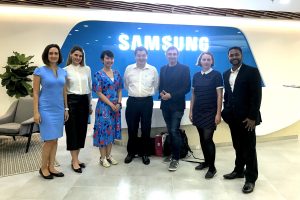The Korean tech giant Samsung has a lot of meaning behind its name. The two syllables, sam meaning “three” and sung meaning “stars,” were chosen to inspire a vision of a company that would become as powerful and eternal as the stars in the sky. In my second Action Learning project, I got to experience this meaning for myself. I had experience with Samsung products before the project as a result of my sales background.
My family’s retail business sold Samsung electronics, which were often fast-moving products with high inventory turnover regardless of the salesperson’s expertise. It all comes down to the brand image. There are some brands to which the question of how you learn about them doesn’t apply, because you have always known about them. Samsung is one of these brands, and I have been impressed by the company for this reason.
I was glad to have the opportunity to complete an Action Learning project with Samsung. Because I was familiar with the brand, especially its Samsung Electronics business segment, I gave the project a high rating on my list of preferences.

I have always found it important to learn about a wide range of different industries and business areas. I enjoy gaining in-depth knowledge about new and vibrant industries and developing solutions that make a significant impact. For this reason, the growing smartphone industry in Malaysia seemed more than appealing to me. Furthermore, the Samsung project itself was even more attractive because it focused on high-level marketing strategy, one of my areas of interest.
I hoped that the diverse perceptions, skills and experiences within my group would help Samsung better plan and implement its marketing strategy. The smartphone industry in Malaysia is saturated and competitive. It is a constant challenge to remain a top player in the market. My team observed the fierce competition and continuous sophisticated upgrades in Samsung models, as well as those of its rivals, during our Action Learning project.
I learned that Samsung Malaysia Electronics was the leading player in Malaysia’s smartphone industry in 2018. It didn’t come as a surprise to me. The company owes its success to its well-established brand and comprehensive portfolio of products in different pricing categories. But success comes with other challenges. As the dominant industry player, the company has a greater need to meet customers’ expectations and even outperform them.
In particular, consumer preference is important for marketers to understand to ensure a brand’s continued dominance. This issue became the focus of our Action Learning project, which I enjoy for its challenging yet compelling nature. There were many directions in which my team and I could have taken the project. We had to think of creative and unconventional ways to find out consumers’ preferences in Malaysia. From there, we determined the consumer buying path and identified the reasons that trigger the decision to upgrade to a new phone.

We had to think of the most efficient ways to collect data to conserve time and resources. We went outside the office to different locations around Kuala Lumpur, talking with people and “stalking” them to find out which have Samsung phones. I learned the design, look and size of a Samsung phone to the extent that I became able to recognize it from a distance.
I was even able to identify Samsung users themselves, regardless of whether they were holding their phones. Yes, that person in a suit drinking his afternoon Americano must be a Note user! We approached people in cafes, restaurants (some girlfriends weren’t happy), in the street, in train stations, you name it. We conducted interviews in taxis and in the queue of a pretzel shop.
I broke the record for the number of times a team member was approached by security guards in shopping malls because of the impermissible interviews I conducted. We had fun along the way, managing to gather a lot of important information for our analysis and observations regarding which factors influence consumers’ buying decisions. I am excited to see the final outcome of our project based on the unconventional approach and findings we derived from it.
I am also grateful that I had the opportunity to work on a project with a prominent brand that has always been at the forefront of technological advancement and innovation. Through this project, I learned not to turn a blind eye to marketing. In today’s globalized world, everyone is competing for the same market, and each company must place great emphasis on its brand, reputation, communication, competition and values to stand out. The market leaders are those who understand what consumers value most, and often all they need to do is ask.





